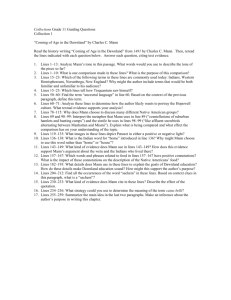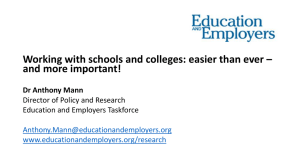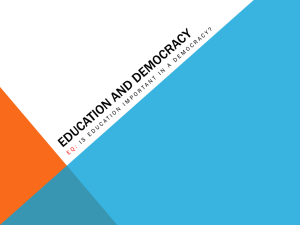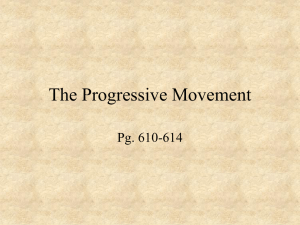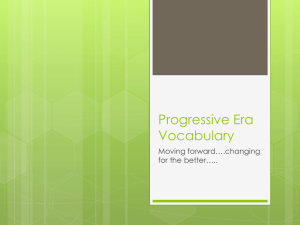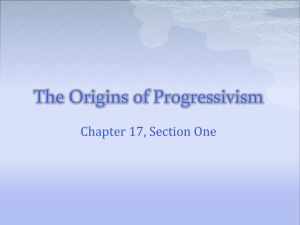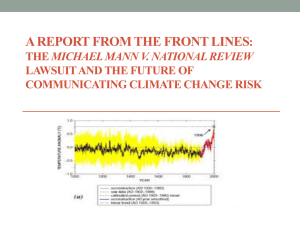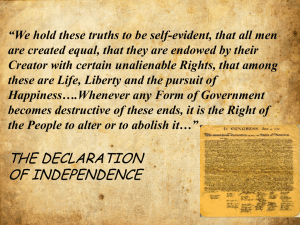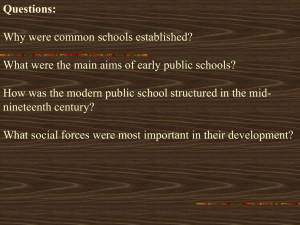Tozer, Chapter 5
advertisement
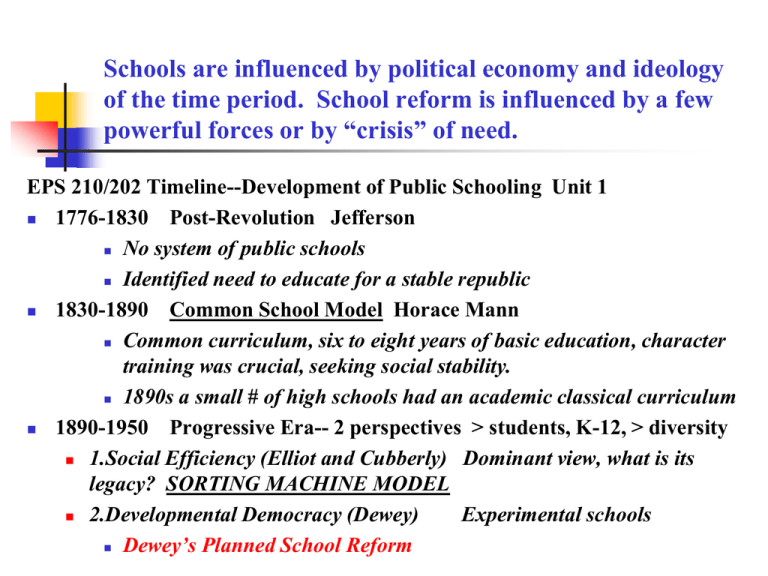
Schools are influenced by political economy and ideology of the time period. School reform is influenced by a few powerful forces or by “crisis” of need. EPS 210/202 Timeline--Development of Public Schooling Unit 1 1776-1830 Post-Revolution Jefferson No system of public schools Identified need to educate for a stable republic 1830-1890 Common School Model Horace Mann Common curriculum, six to eight years of basic education, character training was crucial, seeking social stability. 1890s a small # of high schools had an academic classical curriculum 1890-1950 Progressive Era-- 2 perspectives > students, K-12, > diversity 1.Social Efficiency (Elliot and Cubberly) Dominant view, what is its legacy? SORTING MACHINE MODEL 2.Developmental Democracy (Dewey) Experimental schools Dewey’s Planned School Reform Horace Mann (1837-1848) SOCIAL REFORMER By the 1830s, the time was ripe for public support of elementary education in Massachusetts Can schools help with these kinds of social problems? How? Crime Corruption Drunkenness Delinquency Political violence Class violence How? MORAL TRAINING and DISCIPLINE Purpose of School: To improve society HORACE MANN’S COMMON SCHOOL 4 MEANINGS OF COMMON “EDUCATE ALL IN COMMON” 1. PUBLIC Free, tax-supported education 2. COMMON CURRICULUM Standardization of subject matter and teaching methods. Teach a curriculum not so different from schools in the 1820s and 1830s Basic Skills -Reading, ‘Riting, ‘Rithmetic (3 Rs), spelling, history, geography, music. 4th and 5TH R?? Religion and Republicanism 3. OPEN TO ALL Common experience for diverse students (exception: segregated schools for free blacks in Boston) 4. COMMON IDEOLOGY Teach ideology of the Republic COMMON SCHOOLS HORACE MANN –TO SOLVE SOCIAL PROBLEMS WHAT WAS TAUGHT AND HOW? Basic Skills -Reading, writing, numbers, spelling, history, geography, music. Moral training--linked to religion but tried to “secularize” moral training, but local control allowed for sectarianism to operate. Elementary Level Six years for all students, a longer school year. State made attendance compulsory MANN-- COMMON SCHOOL GOAL: TO PROMOTE SOCIAL STABILITY PROTESTANTISM PROTESTANTISM MORAL LESSONS Mann devised a set of virtues called the “COMMON ELEMENTS” Opposition to Prayers, Bible, how the common elements were taught. Not just on secular grounds, some conservatives wanted more religion. Supported by moderate Protestants OPPOSITION Alienates almost everyone else: Conservative Protestants Nonbelievers, Jews, and Irish Catholics who leave the public school and establish parochial schools (on the Irish, see Urban,Wagoner, 115) Horace Mann Teaching moral values Moral lessons taught through Protestant materials (prayers, stories of virtue and vice, and study of bible). Mann was supported by moderate Protestants. Mann supports Bible readings and “appropriate" set of moral values known as the common elements (in Mann’s 12th Report) What are the common elements? Piety, justice, sacred regard for truth, love of country, humanity, universal benevolence, sobriety, industry, frugality, chastity, moderation, and temperance. Mann believed that human nature can be formed. Common School Advocates Like Mann Were MORALISTS Moral training was as important as teaching basic skills. Mann was driven by a compelling need for moral consensus due to social STRIFE: Religious struggles Economic strife between rich and poor, labor unrest Tensions between Irish immigrants and locals MANN--COMMON SCHOOL TO PROMOTE SOCIAL STABILITY REPUBLICANISM REPUBLICANISM Some political roles for some citizens All members of society needed virtue What kinds of books were used in the schools of the new Republic? Noah Webster’s American Spelling Book** http://www.merrycoz.org/books/spelling/SP ELLING.HTM Webster American Spelling Book Contained: Protestant Catechism Moral lessons in stories Politics Americanization of spelling English words Noah Webster’s Political Training LIMITS of Liberalism American Spelling Book on Voting Q. Can every an [sic “man”] in the states vote for delegates to Congress? A. By no mans [sic]. In almost every state some property is necessary to give a man a right to vote. In general, men who have no estate, pay no taxes, and who have no settled habitation, are not permitted to vote for rulers, because they have no interest to secure, they may be vagabonds or dishonest men, and may be bribed by the rich. Noah Webster’s American Spelling Book Politics Representative Government is best. Q. Is there another and better form of government than any of these? A. There is. A REPRESENTATIVE REPUBLIC[,] in which the people freely choose deputies to make laws for them, is much the best form of government hitherto invented. Raises questions about role of citizen PROGRESSIVE ERA Dramatic Changes in the Political Economy 20th Century SOCIAL CONDITIONS 1900 (Tozer, Chapter 5) Pressures of 1893 Depression, the rise of modern industrial society, urbanization and immigration. Social problems: Immigration Industrialization Low Wages Labor Unrest (Strikes, Riots) Poverty in Cities Child Labor Discrimination What does “progressive” mean? It emerged out of 1893 Depression, spurred interest in all kinds of social and economic reform. Handout Progressive refers to “a movement to organize 20th century American society into an efficiently functioning unit that would be in HARMONY with the needs of a MODERN INDUSTRIAL society.” Progressive means moving towards a more ORDERLY, MORAL, DEMOCRATIC society. (Depending upon how these goals are defined--can create conflicts.) “Efficiently functioning society…[needs to] operate on principles of non-partisan politics, scientific and professional expertise.” In 1900 the question was how to reform public schools to accommodate the large, new student populations---new immigrants, working class, and racial ethnic minorities. TWO VERY DIFFERENT VIEWS OF PROGRESSIVE EDUCATION SCHOOL REFORM Elliot Based on the forces in the Political Economy and Ideology what should be done to reform schools? Dewey 2 Views emerged which differed on Ideology and Social Goals What is one of the most important outcomes of the social efficiency movement? One of the most important outcomes of the Social Efficiency Progressive Education Movement was the differentiated curriculum-college, general, and vocational courses. Today, we differentiate the curriculum with tracks, some career training, and some study/work programs. Some schools provide only limited academic training. Today, the goal for the nation and for Illinois is to prepare all students for post-secondary education. Why study this period? **Developed the Modern School Model-Sorting Machine Model begins Kindergarten--12th grade More students attend Rapid expansion of new schools Added high school Differentiated curriculum-college, general, vocational 14-17 year olds--high school aged students. Dramatic increase of 14-17 year olds who attend school between 1890 and 1940. 1890 7% attended high schools, and half of these students were in private schools 1920 32% attended high school, most in public schools, but only one third graduate. 1940 70% attended high school, but only half graduate Today, almost universal attendance-- 75% graduate HS with a diploma, many of those who dropout later get a GED. What schooling should you expect for your children? If your family worked in a factory, what kind of education could you expect in 1910?____________ This legacy continues until 1980s when scholars raise questions about curriculum and tracking of students. If your family works in a factory or another low income job today, what kind of education should you expect? My expectation would be…. In 1910 how did the differentiated curriculum serve different students? Intended to fit children equally well for their particular life’s work. “Harmony with an industrial society.” How could social efficiency progressives believe they were acting in the name of democracy? (Tozer, 145) They were responding to new social, economic and political conditions, changing ideology, and the “failure” of traditional schools. Today, we question any practice where the structure reproduces class differences. Key question for schools today is: What kind of core preparation (political, social, economic) is needed for a successful life in today’s world? A second important outcome of the social efficiency movement is the widespread use of testing in the schools to place students in different curricular tracks. IQ Testing Movement Aided Social Efficiency Tozer, Chapter 5, 148-159, 160 IQ Tests in World War I was biased against various nationalities, and minority groups Group Testing (paper and pencil tests) for those with limited English, limited school experience, living in poverty Resulted in low IQ Test Scores for those with limited English and limited schooling. Low test scores were thought to mean limited academic ability. Administrative Progressive Professor and Dean Ellwood Cubberly, Stanford University, School of Education 1919 stated in his book: “Largely illiterate, docile, often lacking in initiative, and almost wholly without the Anglo-Saxon conceptions of righteousness, liberty, law, order, public decency, and government, their coming has served to dilute tremendously our national stock and to weaken and corrupt our political life.” Who is Cubberly referring to? The views by Social Efficiency Progressive Educators dominated 20th century schooling. This era began the Sorting Machine Model. Schools should prepare students for their future life Class, gender, and race/ethnicity determined FUNCTION in society-curricular differentiation –college preparation, vocational, and general curriculum. Schools had to run more efficiently Schools should be run by experts Rise of centralization and bureaucracy (large school districts, teachers at the bottom of the hierarchy, less parental input on school boards, large schools) Knowledge as static, could just be “learned”, training for skills Some groups not capable of learning academic subjects Testing assisted in proper placement Racial/ethic, gender, and class discrimination IDEOLOGY SHIFT –The Modern Liberal State Classical Liberalism evolved into Modern Liberalism See Tozer 145-150 Reason-- became defined as Scientific Rationality--Greater influence by science and the use of scientific rationality Reason--New Psychology--Genetic Theories of Intelligence, scientific evidence of capacity through IQ testing, concluded that many were limited in their capacity to reason, targeted certain ethnic groups, behaviorism (learn by stimulus-response, not reason), Freud’s notions of the subconscious and power of emotions over personality and behaviors. Individualism—person is a cell in a larger social organism Virtue—good person replaced with good citizen Progress--via expert planning and management, progress is not inevitable. Natural Law--Darwin’s theory of evolution “universe not fixed” “social Darwinist claimed not all races as fully evolved” “some not fit to survive” Nationalism--Increased nationalism (2 World Wars) Freedom--Laissez-faire government (negative freedom--freedom from interference) replaced by government intervention (to preserve freedom you need an active government and government regulations) Power centered more with EXPERTS. Philosopher John Dewey One of the main leaders Disagreed with Social Efficiency about: Developmental Democracy Progressives disagreed with social efficiency progressives’ views about school reform. Dewey did not support: Differentiated curriculum (supported a unified curriculum) Vocational training in schools (manual training, occupations of life, but not training for specific jobs) Limited view of human capacity (tremendous potential if proper education provided)
